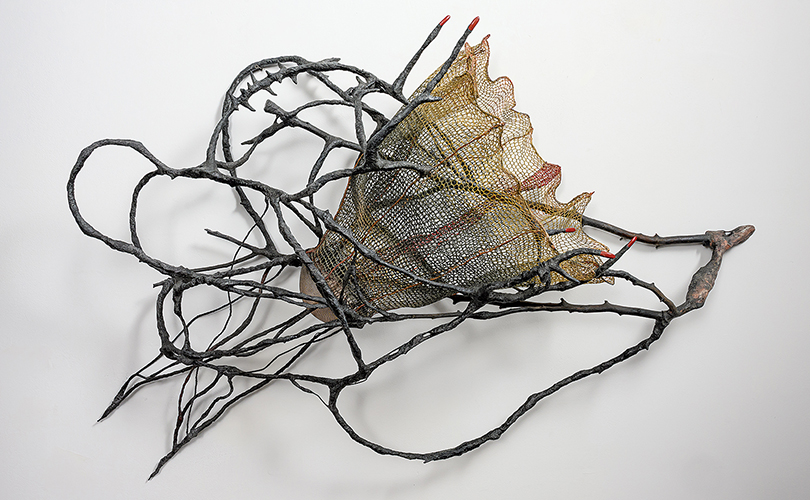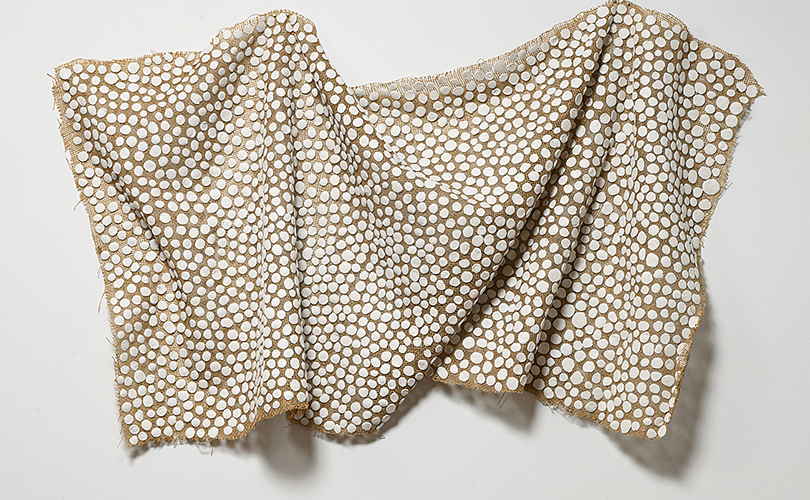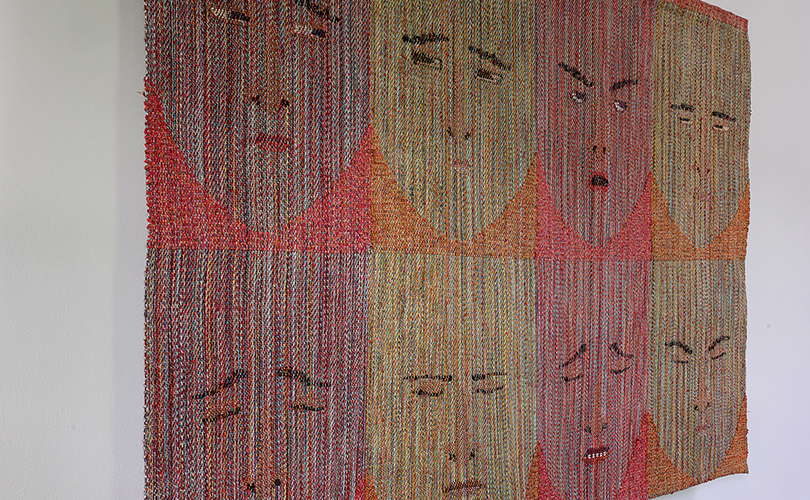Works by Norma Minkowitz, Nnenna Okore, Laura Foster Nicholson, and Gyöngy Laky made up our New this Week selection for November.
Each of these works were featured in our Fall exhibition, Beauty is Resistance: art as antidote. The exhibition highlighted artworks in which artists used beauty as a way speak about agency, identity, anxiety, environmental issues, and more.

Norma Minkowitz is widely known for works of three-dimensional crochet. For Venus Trapped, Minkowitz started with a giant crocheted flower head not really knowing where the sculpture was headed. Her initial inspiration leaned toward creating a female figure in combination with a giant flower head. But then, she started creating thorn-like shapes that resembled female fingernails painting them red. The flower, generally a symbol of renewal, peace, and celebration became a Venus fly trap — a persistent threat to certain species. Thorns and red sharp fingernails appeared to ward off any attacks — a symbol of resistance defending oneself against unwanted behavior.

Born in Australia, raised in Nigeria, and now working in the United States, today Nnenna Okore uses bioplastics as a primary material in her work. However, her present ideas around material transformation took root in earlier works like White Cowries. Okore spent a year as an apprentice in El Anatsui’s studio in Nigeria, an artist who transforms thousands of throwaway metal bottle caps, tops, and fragments into dazzling tapestries that simultaneously confront the effects of the transatlantic slave trade and affirm the majesty of West African textiles like Kente cloth. In Okore’s White Cowries, 2010 draped hessian (burlap) pulses with white clay dots to suggest the depth of symbolic, economic, and historical meaning of the cowrie shell in Nigerian culture.

Laura Foster Nicholson is a textile artist known for her handwoven tapestries. With a BFA from Kansas City Art Institute and and MFA from Cranbrook Academy of Art, she has lectured, taught, and exhibited in the US, Canada and Italy. Her artwork is in several museum collections, including the Art Institute of Chicago, The Minneapolis Institute of Art, and the Denver Art Museum. Grants and awards include an NEA fellowship, the Leone di Pietra prize at the Venice Biennale of Architecture, three Illinois Arts Council fellowships, and a grant from the Graham Foundation for Research in the Fine Arts. She often does fabric and ribbon design commissions, including for Thomas Jefferson’s home, Monticello. “Eight Faces of Concern,” Nicholson says, “was a cathartic response to Trump’s first term. It was so much fun to get each subtle expression about these feelings into weaving. There are a lot of them!”

In the 90s, Gyöngy Laky was enthusiastic when the SC Johnson Wax company sent waste bits of plastic from their manufacturing process to artists to use in their work. At that time, Laky says, many artists were addressing reuse, recycling, post-consumer life for discards, but here a major company joined the conversation. Graceful Exit was the result. Laky began to call of her materials addressing sustainability “industrial harvesting.” The artist is known for her wise and witty juxtapositions of natural and manmade materials. “Laky’s art manifests architectonic sensibility. She is as much an engineer as she is an artist in the conventional sense,” Kenneth Trapp wrote in an introduction to Laky’s oral biography (Nathan, Harriet, Trapp, Kenneth (2003). Gyongy Laky (b. 1944) Fiber Art: Visual Thinking and the Intelligent Hand. Regional Oral History Office, Bancroft Library, University of California, Berkeley, CA: The Regents of the University of California).
Enjoy! More to come in December…
